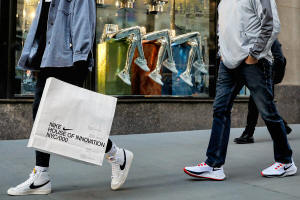U.S. consumer spending, income temporarily fall ahead of massive fiscal
stimulus
 Send a link to a friend
Send a link to a friend
 [March 27, 2021] By
Lucia Mutikani [March 27, 2021] By
Lucia Mutikani
WASHINGTON (Reuters) -U.S. consumer
spending fell by the most in 10 months in February as a cold snap
gripped many parts of the country and the boost from a second round of
stimulus checks to middle- and lower-income households faded.
But the drop in consumer spending, the biggest since mandatory shutdowns
of nonessential businesses like restaurants last April to slow the
spread of COVID-19, is seen as temporary. The economy is poised to log
its best performance in 37 years, thanks to the White House's massive
$1.9 trillion pandemic relief package and increased vaccinations against
the coronavirus.
"The February pullback in income and spending is only a temporary blip,"
said Gregory Daco, chief U.S. economist at Oxford Economics in New York.
"We expect the combination of rising vaccination rates and a new round
of stimulus checks from the largest COVID-19 stimulus package yet will
provide a powerful lift to consumer spending in March."

Consumer spending, which accounts for more than two-thirds of U.S.
economic activity, dropped 1.0% last month amid a broad decline in
purchases of goods, the Commerce Department said on Friday. That
followed a 3.4% rebound in January.
Personal income tumbled 7.1% after surging 10.1% in January. Economists
polled by Reuters had forecast consumer spending would decrease 0.7% in
February and income would decline 7.3%.
Unusually harsh weather in the second half of February, including in
Texas and other parts of the densely populated South region, depressed
homebuilding, production at factories, orders and shipments of
manufactured goods.
Temperatures are rising and the relief package approved this month is
sending additional $1,400 checks to qualified households and extending
the government safety net for the unemployed through Sept. 6. The labor
market recovery is also gaining traction, with first-time applications
for unemployed benefits hitting a one-year low last week.
The brightening health and economic outlook boosted consumers' spirits,
which bodes well for spending. In a separate report on Friday, the
University of Michigan said its consumer sentiment index increased this
month by the most in nearly eight years.
Stocks on Wall Street were trading higher. The dollar rose against a
basket of other currencies. U.S. Treasury prices were lower.

BROAD DECLINE
Last month, spending on goods dropped 3.0%, led by declines in purchases
of pharmaceutical products and recreational items. Spending on services
edged up 0.1% as consumers spent more on utilities and health care at
hospitals, offsetting a decrease in outlays at restaurants.
With demand soft, inflation retreated. But prices are expected to
accelerate owing to the broader re-opening of the economy and the
dropping of last year's weak readings from the calculation, as well as
very accommodative fiscal and monetary policy.
[to top of second column] |

People shop, during the coronavirus disease (COVID-19) pandemic, on
5th Avenue in New York, U.S., February 17, 2021. REUTERS/Brendan
McDermid

Federal Reserve Chair Jerome Powell told lawmakers this week that the
anticipated rise in inflation over the course of the year will be "neither
particularly large nor persistent."
The personal consumption expenditures (PCE) price index excluding the volatile
food and energy component gained 0.1% after rising 0.2% in January. In the 12
months through February, the so-called core PCE price index climbed 1.4% after
increasing 1.5% in January. The core PCE price index is the Fed's preferred
inflation measure for its 2% target, a flexible average.
"Although inflation will move somewhat higher, it will remain well-contained
over the next few years," said Gus Faucher, chief economist at PNC Financial in
Pittsburgh, Pennsylvania. "There is still a lot of slack in the economy."
When adjusted for inflation, consumer spending decreased 1.2% last month after
jumping 3.0% in January. Despite the drop in so-called real consumer spending,
consumption in the first two months of the first quarter is running well above
the fourth quarter average.
A 2.5% increase in the goods trade deficit to $86.7 billion in February, the
second highest on record, reported by the Commerce Department in another report
on Friday, did nothing to dampen enthusiasm about economic growth this quarter.

The report also showed wholesale inventories gaining 0.5% last month and stocks
at retailers unchanged.
With latest data in hand, economists at Morgan Stanley raised their
first-quarter gross domestic product estimate to a 10.0% annualized rate from a
8.7% pace. The economy grew at a 4.3% pace in the fourth quarter. Growth this
year could top 7%, which would be the fastest since 1984. The economy contracted
3.5% in 2020, the worst performance in 74 years.
Income last month was depressed by a 27.4% plunge in government transfers. Wages
were also flat. The saving rate fell to a still-high 13.6% from 19.8% in
January, with economists expecting some of the cash from the latest stimulus
checks will be saved. Households are sitting on about $1.9 trillion in excess
savings.
"We anticipate that hoard will surpass $2 trillion once the latest round of
direct checks hits household income in March and April," said Tim Quinlan, a
senior economist at Wells Fargo Securities in Charlotte, North Carolina. "This
will provide households with ample means to drive spending, not only as the
economy re-opens this year, but into next year as well."
(Reporting by Lucia MutikaniEditing by Chizu Nomiyama and Paul Simao)
[© 2021 Thomson Reuters. All rights
reserved.] Copyright 2021 Reuters. All rights reserved. This material may not be published,
broadcast, rewritten or redistributed.
Thompson Reuters is solely responsible for this content. |